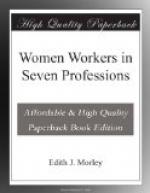In a lecture before the Fabian Women’s Group in February 1912, Miss Florence, of the Association of Women Clerks and Secretaries, said:
“With regard to the sanitary conditions—these as a rule are bad, especially where there is only one woman. The difficulty has been shirked by the women themselves in a great many cases.... I do not see how these can be altered except by improving the status and position of women, so that they may become strong enough to say they will not have it if it is too bad.”
Who is to dictate what is “too bad”? Surely the only remedy is to have a proper standard of decency enforced by law. Women as a rule are fools on this subject, and will endure almost any discomfort, rather than complain.
In giving evidence before the Royal Commission, in May last year, concerning the conditions of employment and their effect on the health of Civil Service female typists and shorthand writers, Miss Charlesworth, Honorary Secretary of the Civil Service Typists’ Association, said:
“The statistics as regards sickness relating to our class are almost too small to be of very much use.... I may say from experience that they are greatly influenced by the conditions under which the work is done. In my own department (Local Government Board) our average absence from sickness in the old office, where we were much overcrowded, varied between ten and fourteen days a year, while in our new office the average has steadily gone down from twelve to a fraction over six last year.... It is very striking that there has been that reduction in the average number of days’ absence per year from sickness, from twelve to six in four years while we have been working under better conditions ... that means a less number of typing machines in one room, more light to work by and more air—better rooms to work in.”
This evidence is interesting, as the worst conditions that could possibly exist in the lofty rooms of a Government office, where everything is on a big scale and there is a certain standard of comfort, must be superior to the majority of commercial offices, especially in London, where space is so expensive. Think of four girls taking shorthand notes by telephone in a room with thirty typewriting machines working at once!




